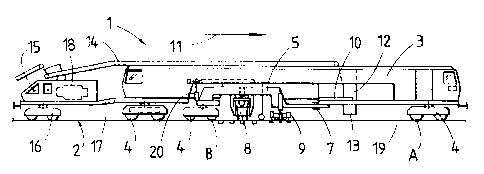Some of the information on this Web page has been provided by external sources. The Government of Canada is not responsible for the accuracy, reliability or currency of the information supplied by external sources. Users wishing to rely upon this information should consult directly with the source of the information. Content provided by external sources is not subject to official languages, privacy and accessibility requirements.
Any discrepancies in the text and image of the Claims and Abstract are due to differing posting times. Text of the Claims and Abstract are posted:
| (12) Patent: | (11) CA 2350166 |
|---|---|
| (54) English Title: | A METHOD AND MACHINE FOR TAMPING A TRACK |
| (54) French Title: | TECHNIQUE ET MACHINE POUR LE BOURRAGE D'UN RAIL |
| Status: | Expired and beyond the Period of Reversal |
| (51) International Patent Classification (IPC): |
|
|---|---|
| (72) Inventors : |
|
| (73) Owners : |
|
| (71) Applicants : |
|
| (74) Agent: | RICHES, MCKENZIE & HERBERT LLP |
| (74) Associate agent: | |
| (45) Issued: | 2005-08-09 |
| (22) Filed Date: | 2001-06-08 |
| (41) Open to Public Inspection: | 2001-12-09 |
| Examination requested: | 2002-04-10 |
| Availability of licence: | N/A |
| Dedicated to the Public: | N/A |
| (25) Language of filing: | English |
| Patent Cooperation Treaty (PCT): | No |
|---|
| (30) Application Priority Data: | ||||||
|---|---|---|---|---|---|---|
|
A track lifting section (19), delimited by two rail undercarriages (4), of a machine (1) for tamping a track is extended in the longitudinal direction of the track in a first working pass for lifting the track and introducing ballast underneath the track 2. In a further working pass for producing the final desired position and for tamping the track (2), the track lifting section (19) is shortened.
Une section de soulèvement de rail (19), délimitée par deux boggies (4), d'une machine (1) de bourrage d'un rail est allongée dans la direction longitudinale du rail dans une première passe pour soulever le rail et placer un ballast sous le rail 2. Au cours d'une passe ultérieure visant à obtenir la position désirée finale et à bourrer le rail (2), la section de soulèvement de rail (19) est raccourcie.
Note: Claims are shown in the official language in which they were submitted.
Note: Descriptions are shown in the official language in which they were submitted.

2024-08-01:As part of the Next Generation Patents (NGP) transition, the Canadian Patents Database (CPD) now contains a more detailed Event History, which replicates the Event Log of our new back-office solution.
Please note that "Inactive:" events refers to events no longer in use in our new back-office solution.
For a clearer understanding of the status of the application/patent presented on this page, the site Disclaimer , as well as the definitions for Patent , Event History , Maintenance Fee and Payment History should be consulted.
| Description | Date |
|---|---|
| Time Limit for Reversal Expired | 2018-06-08 |
| Letter Sent | 2017-06-08 |
| Grant by Issuance | 2005-08-09 |
| Inactive: Cover page published | 2005-08-08 |
| Inactive: Final fee received | 2005-05-25 |
| Pre-grant | 2005-05-25 |
| Notice of Allowance is Issued | 2005-05-05 |
| Letter Sent | 2005-05-05 |
| Notice of Allowance is Issued | 2005-05-05 |
| Inactive: Approved for allowance (AFA) | 2005-04-05 |
| Amendment Received - Voluntary Amendment | 2004-11-24 |
| Inactive: S.30(2) Rules - Examiner requisition | 2004-08-04 |
| Letter Sent | 2002-05-13 |
| Request for Examination Requirements Determined Compliant | 2002-04-10 |
| All Requirements for Examination Determined Compliant | 2002-04-10 |
| Request for Examination Received | 2002-04-10 |
| Application Published (Open to Public Inspection) | 2001-12-09 |
| Inactive: Cover page published | 2001-12-09 |
| Inactive: First IPC assigned | 2001-08-09 |
| Inactive: Filing certificate - No RFE (English) | 2001-07-11 |
| Filing Requirements Determined Compliant | 2001-07-11 |
| Letter Sent | 2001-07-11 |
| Application Received - Regular National | 2001-07-11 |
There is no abandonment history.
The last payment was received on 2005-04-15
Note : If the full payment has not been received on or before the date indicated, a further fee may be required which may be one of the following
Please refer to the CIPO Patent Fees web page to see all current fee amounts.
Note: Records showing the ownership history in alphabetical order.
| Current Owners on Record |
|---|
| FRANZ PLASSER BAHNBAUMASCHINEN-INDUSTRIEGESELLSCHAFT M.B.H. |
| Past Owners on Record |
|---|
| HERBERT WORGOTTER |
| JOSEF THEURER |